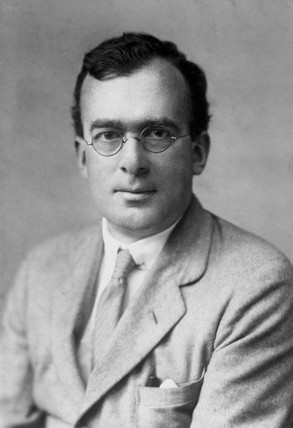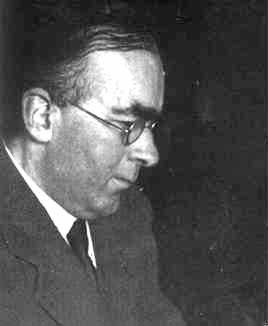<Back to Index>
- Physicist Douglas Rayner Hartree, 1897
- Architect Ludwig Mies van der Rohe, 1886
- Leader of the Soviet Communist Party Sergei Mironovich Kirov (Kostrikov), 1886
PAGE SPONSOR


Douglas Rayner Hartree PhD, FRS (27 March 1897 – 12 February 1958) was an English mathematician and physicist most famous for the development of numerical analysis and its application to the Hartree - Fock equations of atomic physics and the construction of the meccano differential analyser.
Douglas Hartree was born in Cambridge, United Kingdom. His father, William, was a lecturer in engineering at Cambridge University and his mother, Eva Rayner, was president of the National Council of Women and mayor of the city of Cambridge. One of his great - grandfathers was Samuel Smiles. He was the oldest of three sons, although his two younger brothers did not survive to adulthood. He attended St John's College, Cambridge, but the first world war interrupted his studies. He joined a group working on anti - aircraft ballistics under A.V. Hill, where he gained considerable skill and an abiding interest in practical calculation and numerical methods for differential equations, executing most of his own work with pencil and paper. After the end of World War I, Hartree returned to Cambridge graduating in 1922 with a Second Class degree in natural sciences.
In 1921, a visit by Niels Bohr to Cambridge inspired Douglas to apply his numerical skills to Bohr’s theory of the atom for which he obtained his Ph.D. in 1926. With the publication of Schrödinger’s equation in the same year, Douglas was able to apply his knowledge of differential equations and numerical analysis to the new quantum theory. He derived the Hartree equations for the distribution of electrons in an atom and proposed the self - consistent field method for their solution. The wave functions from this theory did not satisfy the Pauli exclusion principle for which Slater showed that determinantal functions are required. V. Fock published the ``equations with exchange’’ now known as Hartree - Fock equations. These are considerably more demanding computationally even with the efficient methods Hartree proposed for the calculation of exchange contributions.
In 1929, Hartree was appointed to the Beyer Chair of Applied Mathematics at the University of Manchester. In 1933, he visited Vannevar Bush at the Massachusetts Institute of Technology and learned at first hand about his differential analyser. Immediately on his return to Manchester, he set about building his own analyser from Meccano. Seeing the potential for further exploiting his numerical methods using the machine he prevailed on Sir Robert McDougall to fund a more robust machine which was built in collaboration with Metropolitan - Vickers.
The first application of the machine reflected Hartree's enthusiasm for railways in calculating timetables for the London, Midland and Scottish Railway. He spent the rest of the decade apply the differential analyzer to the solution of differential equations arising in physics. These included control theory and laminar boundary layer theory in fluid dynamics making significant contributions to each of the fields.
The differential analyzer was not suitable for the solution of equations with exchange. When Fock’s publication pre-empted Hartree’s work on equations with exchange, Hartree turned his research to radio - wave propagation that led to the Appleton - Hartree equation. In 1935, his father, William Hartree, offered to do calculations for him. Results with exchange soon followed. Douglas recognized the importance of configuration interaction that he referred to as "superposition of configurations". The first multiconfiguration Hartree - Fock results were published by father, son, and Bertha Swirles (later Lady Jeffreys) in 1939.
At Hartree’s suggestion, Bertha Swirles proceeded to derive equations with exchange for atoms using the Dirac equation in 1935. With Hartree’s advice, the first relativistic calculations (without exchange) were reported in 1940 by A.O. Williams, a student of R.B. Lindsay.
During World War II, Hartree supervised two computing groups. The first group, for the Ministry of Supply, has been described by Jack Howlett as
a ‘`job shop’’ for the solution of differential equations. At the
outbreak of World War II, the differential analyzer at the University
of Manchester was the only full size (8 integrator) differential
analyzer in the country. Arrangements were made to have the machine
available for work in support of the national war effort. In time, the
group consisted of four members (Jack Howlett, Nicholas R. Eyres, J.G.L. Michel; Douglas Hartree; Phyllis Lockett Nicolson). Problems were
submitted to the group without information about the source but
included the automatic tracking of targets, radio propagation,
underwater explosions, heat flow in steel, and the diffusion equation
later found to be for isotope separation. The second group was the
magnetron research group of Phyllis Lockett Nicolson, David Copely, and Oscar Buneman.
The work was done for the Committee for the Co-ordination of the Valve
Development assisting the development of radar. A differential analyzer
could have been used if more integrators had been available, so Hartree
set up his group as three "CPUs" to work on mechanical desk calculators
in parallel. For a method of solution he selected what is now a
classical particle simulation. Hartree
never published any of his magnetron research findings in journals
though he wrote numerous highly technical secret reports during the war. Hartree
had moved to theoretical physics in 1937 before returning to Cambridge
to take up the post of Plummer professor of mathematical physics in
1946. He did further work in control systems and was involved in the early application of digital computers, advising the U.S. military on the use of ENIAC for calculating ballistics tables. In 1946 he was the first civilian to program the ENIAC as
an evaluation of its applicability to a broad range of science. For
this he selected a problem involving the flow of a compressible fluid
over a surface such as air over the surface of a wing travelling faster
than the speed of sound. Hartree's last Ph.D. student at Cambridge, Charlotte Froese Fischer, would become world famous for the development and implementation of the multi - configuration Hartree – Fock (MCHF) approach to atomic structure calculations and for her theoretical prediction concerning the existence of the negative calcium ion. He died of heart failure in Addenbrooke's Hospital, Cambridge, in Feb. 12, 1958.